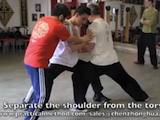Hi everyone!
I have been practicing Yang style Tai chi and qi gong for the past 5 years and recently have very much interest in the practical method.
I practice the foundations and learn the yilu choreography.
My spine structure shows major lordosis and kyphosis with forward head posture. The years of practice improved it maybe a little, but it seems that my spine would be able to be improved up to a point.
A straight spine is crucial for Tai chi capability… and every once in a while I get discouraged. I practice everyday, and it is a major part in my life, so I´m sure I would never stop.
Please shed some light, about the importance of spine alignment.
Every comment would be appreciated.
Thank you!
Alon



{ 3 comments… read them below or add one }
By holding your head fixed and stretching your tail bone down, your spine should be stretched, and over time, it should help with your issue.
Another method of aligning the spine is to use a physically measurable device….strangely enough the device in this case is a blank wall.
Method 1: place both your heels shoulder width apart touching the wall. The knees can be slightly bent using a basic horse stance. Ensure that your upper buttocks, lower back (normally curved in) mid spine and shoulder blades are touching the wall. Head is pulled in as well to ideally touch the wall. Especially important is the spine and lower back touching the wall. Head should be stretched towards the ceiling while everything from the waist is stretching down. The spine is elongated, but the problem is when you come off the wall and duplicate this stance without being against the wall. Any movement doing form interrupts this alignment so constant vigilance and body awareness is needed.
Method 2: Same wall, but now the stance is much wider than the shoulders and the heels are about 15cm in front of the wall. From this position lean back and attach body parts to the wall as in Method 1. Again make sure the lower back curve is eliminated and the spine is against the wall. Now lower the body by sliding down the wall while bending the knees and keeping torso and head vertical. You will find as you lower the body, the lower back and spine start to be more cooperative and touch the wall. From your lowest position use the feet to push yourself up the wall to your starting position. Repeat at least 10 times. Now leave the wall and if possible use a mirror to see if you can duplicate the action away from the wall. This exercise allows movement and lets you be adjusted correctly while moving.
Method 3: This one is to align the spine and stretch it. Stand in a narrow Horse Stance with the feet slightly wider than the shoulders – toes turned out, of course. lower back flat, head aiming towards the ceiling from the crown. Use breathing for this one. Inhale to the Dantian without expanding the chest – the stomach will be pulled in. At the same time also pull in the lower left and right sides of the abdomen while stretching the top of the head upwards and the hip area down. This elongates the spine and eventually helps to keep everything aligned and straight.
These exercises are ones that I have used for aligning the spine and correcting posture and has worked well for helping individuals with posture issues.
Of course if you like method 2, another use is to add a sponge sheet and soap to your back and the walls will be very clean while you gain alignment. Sorry, had to add the twisted humor!
Hi Alon, practice the Practical Method 13 moves or YiLu, get really good at them. But above and beyond all, practice the Practical Method foundation exercise “Fetch Water”. Fetch Water will create the foundation for everything else, including providing the base from which your spine can start sitting properly.